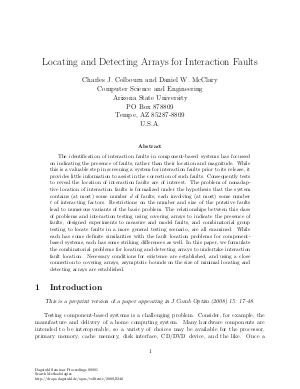Locating and Detecting Arrays for Interaction Faults
Authors Charles J. Colbourn, Daniel W. McClary
-
Part of:
Volume:
Dagstuhl Seminar Proceedings, Volume 9281
Part of: Series: Dagstuhl Seminar Proceedings (DagSemProc) - License:
 Creative Commons Attribution 4.0 International license
Creative Commons Attribution 4.0 International license
- Publication Date: 2009-11-10
File

PDF
DagSemProc.09281.3.pdf
- Filesize: 288 kB
- 34 pages
Document Identifiers
Subject Classification
Keywords
- Covering array
- Orthogonal array
- Factorial design
- Cover-free family
- Disjunct matrix
- Locating array
- Detecting array
Metrics
- Access Statistics
-
Total Accesses (updated on a weekly basis)
0PDF Downloads0Metadata Views
Abstract
The identification of interaction faults in component-based systems has focused on indicating the presence of faults, rather than their location and magnitude. While this is a valuable step in screening a system for interaction faults prior to its release, it provides little information to assist in the correction of such faults. Consequently tests to reveal the location of interaction faults are of interest. The problem of nonadaptive location of interaction faults is formalized under the hypothesis that the system contains (at most) some number d of faults, each involving (at most) some number t of interacting factors. Restrictions on the number and size of the putative faults lead to numerous variants of the basic problem. The relationships between this class of problems and interaction testing using covering arrays to indicate the presence of faults, designed experiments to measure and model faults, and combinatorial group testing to locate faults in a more general testing scenario, are all examined. While each has some definite similarities with the fault location problems for component-based systems, each has some striking differences as well. In this paper, we formulate the combinatorial problems for locating and detecting arrays to undertake interaction fault location. Necessary conditions for existence are established, and using a close connection to covering arrays, asymptotic bounds on the size of minimal locating and detecting arrays are established. A final version of this paper appears in J Comb Optim (2008) 15: 17-48.
Cite As Get BibTex
Charles J. Colbourn and Daniel W. McClary. Locating and Detecting Arrays for Interaction Faults. In Search Methodologies. Dagstuhl Seminar Proceedings, Volume 9281, pp. 1-34, Schloss Dagstuhl – Leibniz-Zentrum für Informatik (2009)
https://doi.org/10.4230/DagSemProc.09281.3
BibTex
@InProceedings{colbourn_et_al:DagSemProc.09281.3,
author = {Colbourn, Charles J. and McClary, Daniel W.},
title = {{Locating and Detecting Arrays for Interaction Faults}},
booktitle = {Search Methodologies},
pages = {1--34},
series = {Dagstuhl Seminar Proceedings (DagSemProc)},
ISSN = {1862-4405},
year = {2009},
volume = {9281},
editor = {Rudolf Ahlswede and Ferdinando Cicalese and Ugo Vaccaro},
publisher = {Schloss Dagstuhl -- Leibniz-Zentrum f{\"u}r Informatik},
address = {Dagstuhl, Germany},
URL = {https://drops.dagstuhl.de/entities/document/10.4230/DagSemProc.09281.3},
URN = {urn:nbn:de:0030-drops-22405},
doi = {10.4230/DagSemProc.09281.3},
annote = {Keywords: Covering array, Orthogonal array, Factorial design, Cover-free family, Disjunct matrix, Locating array, Detecting array}
}
